Inside the Titan Supercomputer: 299K AMD x86 Cores and 18.6K NVIDIA GPUs
by Anand Lal Shimpi on October 31, 2012 1:28 AM EST- Posted in
- CPUs
- IT Computing
- Cloud Computing
- HPC
- GPUs
- NVIDIA
Introduction
Earlier this month I drove out to Oak Ridge, Tennessee to pay a visit to the Oak Ridge National Laboratory (ORNL). I'd never been to a national lab before, but my ORNL visit was for a very specific purpose: to witness the final installation of the Titan supercomputer.
ORNL is a US Department of Energy laboratory that's managed by UT-Battelle. Oak Ridge has a core competency in computational science, making it not only unique among all DoE labs but also making it perfect for a big supercomputer.
Titan is the latest supercomputer to be deployed at Oak Ridge, although it's technically a significant upgrade rather than a brand new installation. Jaguar, the supercomputer being upgraded, featured 18,688 compute nodes - each with a 12-core AMD Opteron CPU. Titan takes the Jaguar base, maintaining the same number of compute nodes, but moves to 16-core Opteron CPUs paired with an NVIDIA Kepler K20X GPU per node. The result is 18,688 CPUs and 18,688 GPUs, all networked together to make a supercomputer that should be capable of landing at or near the top of the TOP500 list.
We won't know Titan's final position on the list until the SC12 conference in the middle of November (position is determined by the system's performance in Linpack), but the recipe for performance is all there. At this point, its position on the TOP500 is dependent on software tuning and how reliable the newly deployed system has been.
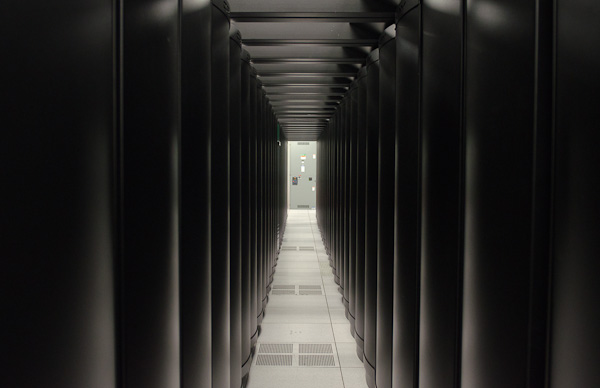
Rows upon rows of cabinets make up the Titan supercomputer
Over the course of a day in Oak Ridge I got a look at everything from how Titan was built to the types of applications that are run on the supercomputer. Having seen a lot of impressive technology demonstrations over the years, I have to say that my experience at Oak Ridge with Titan is probably one of the best. Normally I cover compute as it applies to making things look cooler or faster on consumer devices. I may even dabble in talking about how better computers enable more efficient datacenters (though that's more Johan's beat). But it's very rare that I get to look at the application of computing to better understanding life, the world and universe around us. It's meaningful, impactful compute.
The Hardware
In the 15+ years I've been writing about technology, I've never actually covered a supercomputer. I'd never actually seen one until my ORNL visit. I have to say, the first time you see a supercomputer it's a bit anticlimactic. If you've ever toured a modern datacenter, it doesn't look all that different.
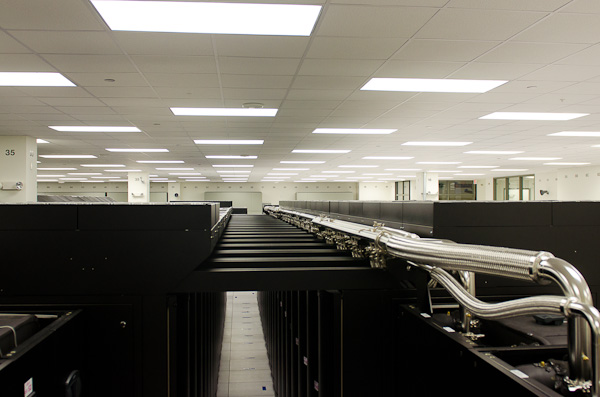
More Titan, the metal pipes carry coolant
Titan in particular is built from 200 custom 19-inch cabinets. These cabinets may look like standard 19-inch x 42RU datacenter racks, but what's inside is quite custom. All of the cabinets that make up Titan requires a room that's about the size of a basketball court.
The hardware comes from Cray. The Titan installation uses Cray's new XK7 cabinets, but it's up to the customer to connect together however many they want.
ORNL is actually no different than any other compute consumer: its supercomputers are upgraded on a regular basis to keep them from being obsolete. The pressures are even greater for supercomputers to stay up to date, after a period of time it actually costs more to run an older supercomputer than it would to upgrade the machine. Like modern datacenters, supercomputers are entirely power limited. Titan in particular will consume around 9 megawatts of power when fully loaded.
The upgrade cycle for a modern supercomputer is around 4 years. Titan's predecessor, Jaguar, was first installed back in 2005 but regularly upgraded over the years. Whenever these supercomputers are upgraded, old hardware is traded back in to Cray and a credit is issued. Although Titan reuses much of the same cabinetry and interconnects as Jaguar, the name change felt appropriate given the significant departure in architecture. The Titan supercomputer makes use of both CPUs and GPUs for compute. Whereas the latest version of Jaguar featured 18,688 12-core AMD Opteron processors, Titan keeps the total number of compute nodes the same (18,688) but moves to 16-core AMD Opteron 6274 CPUs. What makes the Titan move so significant however is that each 16-core Opteron is paired with an NVIDIA K20X (Kepler GK110) GPU.
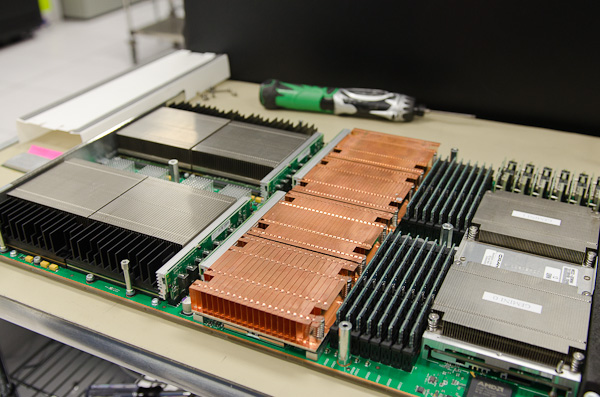
A Titan compute board: 4 AMD Opteron (16-core CPUs) + 4 NVIDIA Tesla K20X GPUs
The transistor count alone is staggering. Each 16-core Opteron is made up of two 8-core die on a single chip, totaling 2.4B transistors built using GlobalFoundries' 32nm process. Just in CPU transistors alone, that works out to be 44.85 trillion transistors for Titan. Now let's talk GPUs.
NVIDIA's K20X is the server/HPC version of GK110, a part that never had a need to go to battle in the consumer space. The K20X features 2688 CUDA cores, totaling 7.1 billion transistors per GPU built using TSMC's 28nm process. With a 1:1 ratio of CPUs and GPUs, Titan adds another 132.68 trillion transistors to the bucket bringing the total transistor count up to over 177 trillion transistors - for a single supercomputer.
I often use Moore's Law to give me a rough idea of when desktop compute performance will make its way into notebooks and then tablets and smartphones. With Titan, I can't even begin to connect the dots. There's just a ton of computing horsepower available in this installation.
Transistor counts are impressive enough, but when you do the math on the number of cores it's even more insane. Titan has a total of 299,008 AMD Opteron cores. ORNL doesn't break down the number of GPU cores but if I did the math correctly we're talking about over 50 million FP32 CUDA cores. The total computational power of Titan is expected to be north of 20 petaflops.
Each compute node (CPU + GPU) features 32GB of DDR3 memory for the CPU and a dedicated 6GB of GDDR5 (ECC enabled) for the K20X GPU. Do the math and that works out to be 710TB of memory.
System storage is equally impressive: there's a total of 10 petabytes of storage in Titan. The underlying storage hardware isn't all that interesting - ORNL uses 10,000 standard 1TB 7200 RPM 2.5" hard drives. The IO subsystem is capable of pushing around 240GB/s of data. ORNL is considering including some elements of solid state storage in future upgrades to Titan, but for its present needs there is no more cost effective solution for IO than a bunch of hard drives. The next round of upgrades will take Titan to around 20 - 30PB of storage, at peak transfer speeds of 1TB/s.
Most workloads on Titan will be run remotely, so network connectivity is just as important as compute. There are dozens of 10GbE links inbound to the machine. Titan is also linked to the DoE's Energy Sciences Network (ESNET) 100Gbps backbone.










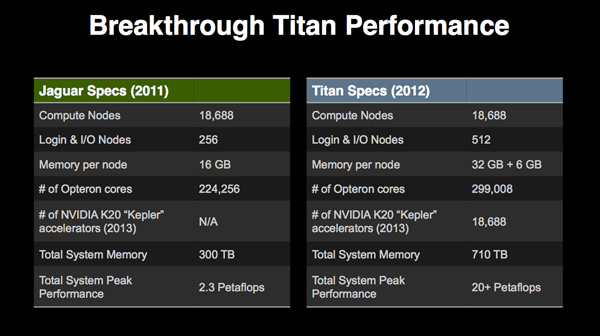
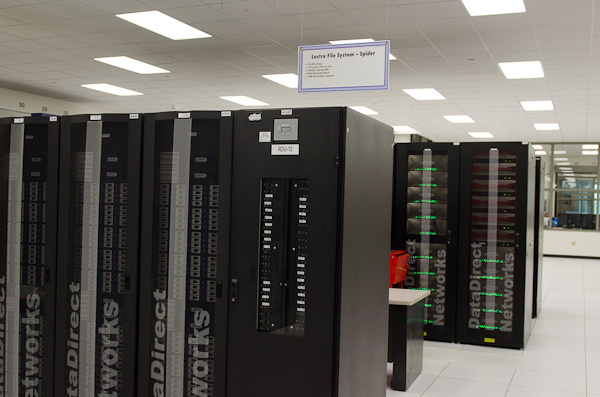
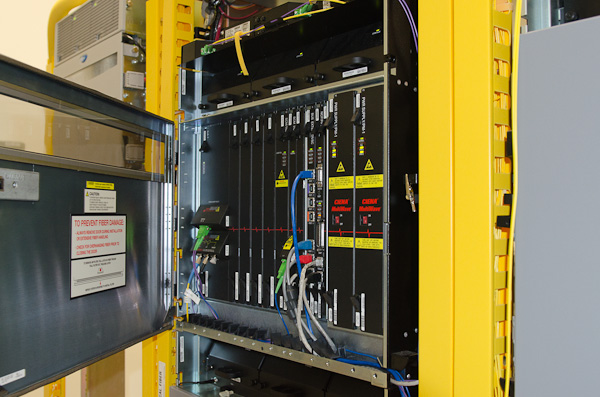








130 Comments
View All Comments
galaxyranger - Sunday, November 4, 2012 - link
I am not intelligent in any way but I enjoy reading the articles on this site a great deal. It's probably my favorite site.What I would like to know is how does Titan compare in power to the CPU that was at the center of the star ship Voyager?
Also, surely a supercomputer like Titan is powerful enough to become self aware, if it had the right software made for it?
Hethos - Tuesday, November 6, 2012 - link
For your second question, if it has the right software then any high-end consumer desktop PC could become self-aware. It would work rather sluggishly, compared to some sci-fi AIs like those in the Halo universe, but would potentially start learning and teaching itself.Daggarhawk - Tuesday, November 6, 2012 - link
Hethos that is not by any stretch certain. Since "self awareness" or "consciousness" has never been engineered or simulated, it is still quite uncertain what the specific requirements would be to produce it. Yet here you're not only postulating that all it would take would be the right OS but also how well it would perform. My guess is that Titan would much sooner be able to simulate a brain (and therefore be able to learn, think, dream, and do all the things that brains do) much sooner than it would /become/ "a brain" It look a 128 core computer a 10hr run render a few-minute simulation of a complete single celled organism . Hard to say how much more compute power it would take to fully simulate a brain and be able to interact with it in real time. as for other methods of AI, it may take totally different kinds of hardware and networking all together.quirksNquarks - Sunday, November 4, 2012 - link
Thank You,this was a perfectly timed article - as people have forgotten why it is important the Technology keeps pushing boundaries regardless of *daily use* stagnation.
Also is a great example of why AMD does offer 16-core Chips. For These Kinds of Reasons! More Cores on One Chip means Less Chips are needed to be implemented - powered - tested - maintained.
an AMD 4 socket Mobo offers 64 cores. A personal Supercomputer. (Just think of how many they'll stuff full of ARM cores).
why Nvidia GPUs ?
a) Error Correction Code
b) CUDA
as to the CPUs...
http://www.newegg.ca/Product/Product.aspx?Item=N82...
$599 for every AMD 6274 chip (obvi they don't pay as much when ordering 300k).
vs
http://www.newegg.ca/Product/Product.aspx?Item=N82...
$1329 for an Intel Sandy Bridge equivalent which isn't really an equivalent considering these do NOT run in 4 socket designs. (obvi a little less when ordering in bulk numbers).
now multiple that price difference (the ratio) in the order of 10's of THOUSANDS!!
COMMON SENSE people.... Less Money for MORE CORES - or - More Money for LESS CORES ?
which road would YOU take? if you were footing the $ Bill.
but the Biggest thing to consider...
ORNL Upgraded from Jaguar <> Titan - which meant they ONLY needed a CHIP upgrade in that regards (( SAME SOCKET )) .. TRY THAT WITH INTEL > :P
phoenicyan - Monday, November 5, 2012 - link
I'd like to see description of logical architecture. I guess it could be 16x16x73 3D Torus.XyaThir - Saturday, November 10, 2012 - link
Nice article, too bad there is nothing about the storage in this HPC cluster!logain7997 - Tuesday, November 13, 2012 - link
Imagine the PPD this baby could produce folding. 0.0hyperblaster - Tuesday, December 4, 2012 - link
In addition to the bit about ECC, nVidia really made headway over AMD primarily because of CUDA. nVidia specially targeted a whole bunch of developers of popular academic software and loaned out free engineers. Experienced devs from nVidia would actually do most of the legwork to port MPI code to CUDA, while AMD did nothing of the sort. Therefore, there is now a large body of well-optimized computational simulation software that supports CUDA (and not OpenCL). However, this is slowly changing and OpenCL is catching on.Jag128 - Tuesday, January 15, 2013 - link
I wonder if it could play crysis on full?mikbe - Friday, June 28, 2013 - link
I was actually surprise at how many actual times the word "actually" was actually used. Actually, the way it's actually used in this actual article it's actually meaningless and can actually be dropped, actually, most of the actual time.